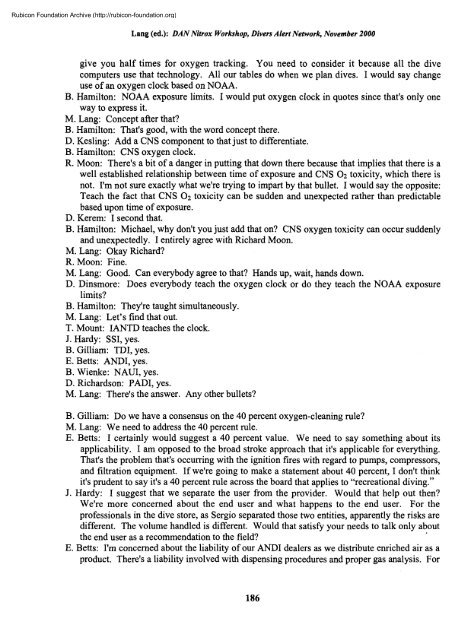Nitrox workshop dings - Divers Alert Network
Nitrox workshop dings - Divers Alert Network
Nitrox workshop dings - Divers Alert Network
You also want an ePaper? Increase the reach of your titles
YUMPU automatically turns print PDFs into web optimized ePapers that Google loves.
Rubicon Foundation Archive (http://rubicon-foundation.org)Lang (ed.): DAN <strong>Nitrox</strong> Workshop, <strong>Divers</strong> <strong>Alert</strong> <strong>Network</strong>, November 2000give you half times for oxygen tracking. You need to consider it because all the divecomputers use that technology. All our tables do when we plan dives. I would say changeuse of an oxygen clock based on NOAA.B. Hamilton: NOAA exposure limits. I would put oxygen clock in quotes since that's only oneway to express it.M. Lang: Concept after that?B. Hamilton: That's good, with the word concept there.D. Kesling: Add a CNS component to that just to differentiate.B. Hamilton: CNS oxygen clock.R. Moon: There's a bit of a danger in putting that down there because that implies that there is awell established relationship between time of exposure and CNS O2 toxicity, which there isnot. I'm not sure exactly what we're trying to impart by that bullet. I would say the opposite:Teach the fact that CNS O2 toxicity can be sudden and unexpected rather than predictablebased upon time of exposure.D. Kerem: I second that.B. Hamilton: Michael, why don't you just add that on? CNS oxygen toxicity can occur suddenlyand unexpectedly. I entirely agree with Richard Moon.M. Lang: Okay Richard?R. Moon: Fine.M. Lang: Good. Can everybody agree to that? Hands up, wait, hands down.D. Dinsmore: Does everybody teach the oxygen clock or do they teach the NOAA exposurelimits?B. Hamilton: They're taught simultaneously.M. Lang: Let's find that out.T. Mount: IANTD teaches the clock.J. Hardy: SSI, yes.B. Gilliam: TDLyes.E. Betts: ANDLyes.B. Wienke: NAUI, yes.D. Richardson: PADI, yes.M. Lang: There's the answer. Any other bullets?B. Gilliam: Do we have a consensus on the 40 percent oxygen-cleaning rule?M. Lang: We need to address the 40 percent rule.E. Betts: I certainly would suggest a 40 percent value. We need to say something about itsapplicability. I am opposed to the broad stroke approach that it's applicable for everything.That's the problem that's occurring with the ignition fires with regard to pumps, compressors,and filtration equipment. If we're going to make a statement about 40 percent, I don't thinkit's prudent to say it's a 40 percent rule across the board that applies to "recreational diving."J. Hardy: I suggest that we separate the user from the provider. Would that help out then?We're more concerned about the end user and what happens to the end user. For theprofessionals in the dive store, as Sergio separated those two entities, apparently the risks aredifferent. The volume handled is different. Would that satisfy your needs to talk only aboutthe end user as a recommendation to the field?E. Betts: I'm concerned about the liability of our ANDI dealers as we distribute enriched air as aproduct. There's a liability involved with dispensing procedures and proper gas analysis. For186
















